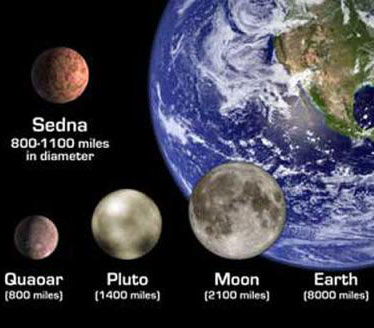kuulani
New Member

Despite our best efforts, neighbors can sometimes be cold and distant. That's certainly the case with Sedna, a newly discovered planetoid that's 8 billion miles away and has temperatures in the -400 degree range.
Sedna, named after Inuit goddess of the sea, is roughly three time further from Earth than Pluto. At about 1,000 miles in diameter, it's too small to be classified as a plant. Instead Sedna must be content with the somewhat less prestigious title of "planetoid."
According to NASA, Sedna is the most distant object yet discovered in the solar system (a NASA artist's conception can be seen above). The planetoid follows an comet-like elliptical orbit, which takes a mind-bending 10,500 Earth years to complete. At it's most distant, Sedna is 84 billion miles from the Sun. At that distance, the Sun would appear to be about the size of the head of a pin.
Based on the planetoid's slow rotation, astronomers believe Sedna may have a moon. It rotates once every 40 Earth days, a relatively slow pace for an object of its size.
Sedna is the largest object found in the solar system since the discovery of Pluto in 1930. It's thought to be part of the previously hypothetical Oort cloud, a vast field of planetoids and asteroid-like objects at the outer limits of the solar system.
Little is know about Sedna other than its size, surface temperature and the fact that it is reddish in color. Astronomers say the planetoid is only slightly less red than Mars.
Sedna was discovered by a research team at the California Institute of Technology, led by Dr. Michael Brown. The planetoid was actually found on November 14, 2003, but scientists waited some months to verify the discovery and analyze data on the object.
Astronomers may gain a better understanding of Sedna in the next few decades. The planetoid will makes a relatively close approach to Earth during the next 72 years, before swinging far out from the on its slow transit around the sun.
The discovery of Sedna is likely to reignite a simmering debate over what constitutes a planet. In recent years, many astronomers have expressed doubt that Pluto, with a diameter of 1,400 miles and an elliptical orbit, should be considered a planet.
did this planet just pop out of thin air?
 :aheadbang:
:aheadbang:

